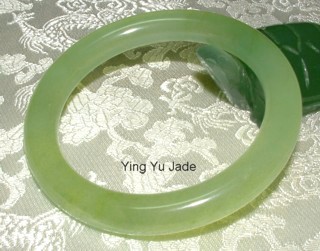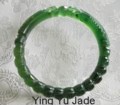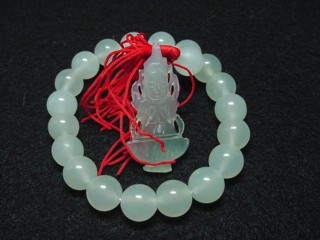Natural Jade from Xiuyan, China
This jade comes from Xiuyan in Liaoning Province in the northeastern part of China where it is mined locally. It is a natural light green color and very translucent. It is sometimes called "water jade" because of its clear, watery appearance. The color is fairly uniform, and you can see some variations of the natural minerals. The jade pendants and bangle bracelets have not had any inclusions or colors removed, or enhancements added. When you look through a bangle bracelet, you will see the jade in its natural state. It will not be completely clear, like glass. In fact, you if you see a bangle in the $10-50 price range that is perfectly clear, it has been enhanced or may not be real jade. Because Xiuyan jade is not as hard as Burmese jadeite, the pendants can be intricately carved, and are very beautiful. Real jade is cool to the touch, and feels heavy in the hand. This is the jade that Chinese people prefer to own
Rough jade from the Xiuyan mine
Parially carved bangles ready to get polished
Carving and polishing
Each piece is hand polished
Jade has been mined here for over 200 years. These mines produce natural jade stone in five colors, including green, white, lavender, red and shades of yellow/brown/honey.
Xiuyan Chinese jade is "China's National Jade" and a museum nearby displays ancient as well as modern jade carvings, with some pieces priced in the millions of dollars. Chinese jade has been cherished for centuries, and Burmese jadeite is relatively "new" to China, a little more than 100 years.
Chinese jade is not nephrite, and it's not serpentine. Western gemologists often declare that Chinese jade is not "real" jade, but then can't explain that this kind of jade is displayed in museums as "jade" and is centuries old. To understand why there's so much confusion obout what is and is not jade, first you have to know that most jade articles are written by Western gemologists, and Western and Asian gemology is different, as is the Western and Asian mind set. Burmese jadeite is the "gem quality" because it is what one usually sees made into jewelry, and jewelers are often gemologists, so they consider Burmese jadeite the only "real" jade. If you take your Chinese jade bangle bracelet or pendant to your jeweler, you will probably be told it isn't "jade". But in China, Chinese jade is the original and National jade. You can read more about Burmese jadeite, click here.
Photos of He Hua Chinese Jade Market
One of the more interesting pieces is the carved jade spice bag. This is a very traditional piece that goes back before the time of bottles. The spice bags are carved with many open spaces and a hole in each side in which to place spice or other perfumes. The fragrance is then dispersed. I use one of these spice bags, also called perfume bottles, as an air freshener for my car and in my office and home.

Spice
Bags


Where would you like to go from here?
Ying
Yu Jade and Pearls Store
Chinese Jade and
Burmese Jadeite
Visit my Chinese Herbs and Tea Store
